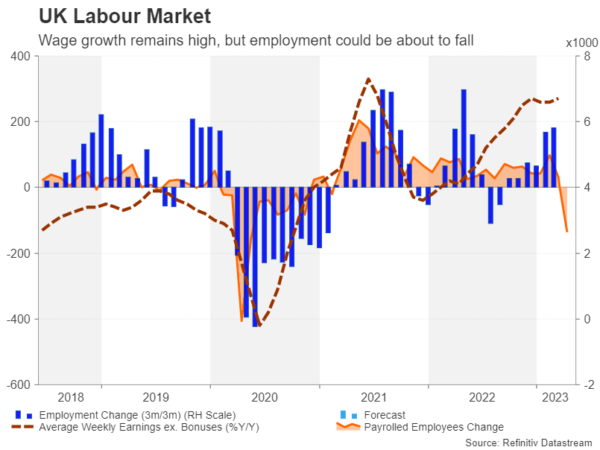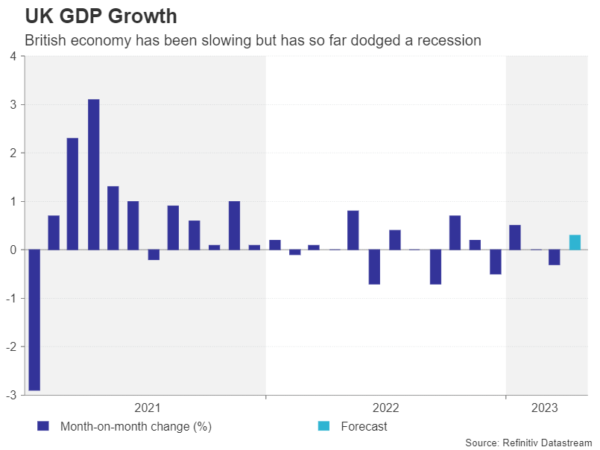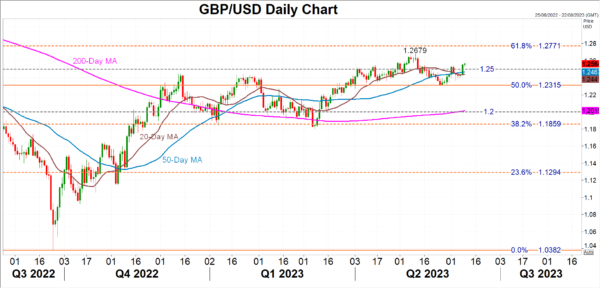The Bank of England doesn’t meet for another couple of weeks and there is quite a bit of data for traders to sift through until then, including employment and GDP numbers for April. The employment report is out on Tuesday followed by the GDP estimate on Wednesday, both due at 06:00 GMT. With inflation still running hot, the choice for the BoE isn’t so much between a hike and a pause but rather, between a small rate increase and a larger one. Stronger-than-expected readings could boost the odds for the latter, lifting the pound.
Some cracks are forming in the labour market
The UK economy has so far avoided a technical recession but nevertheless it ended the first quarter on a weak note. The April stats will therefore be vital to see whether economic output bounced back after the March dip, as despite defying the odds of a recession, the risk of one hasn’t entirely dissipated and even the labour market is showing some signs of a crack.
The unemployment rate has been edging higher since September and could reach 4.0% in the April quarter, having risen to 3.9% in the three months to March. Unusually, total employment has also been growing during this period and was up an impressive 182k in March. However, the more up-to-date payrolls estimate, which is based on data of payrolled employees collected from the UK tax office, points to a sharp deterioration.
BoE wants to see lower wage growth
Payrolled employees fell by 135k in April, suggesting that the official employment figure for the same period will also be weaker. A slowdown in jobs growth would be good news for policymakers, however, as a tight labour market has kept wage growth running around 6% since last August.
When excluding bonuses, average weekly earnings growth has been even stronger and is forecast to hit 6.9% y/y in the three months to April. Without a substantial deceleration in pay growth, the Bank of England will feel pressured to keep hiking rates amid a stubbornly high inflation rate.
A resilient economy
The expectation that UK interest rates will have to rise a lot higher than in other advanced economies has had a mixed effect on sterling as a recession might be the only eventual outcome should inflation not come down fast enough. The Bank of England has been trying to strike a careful balance to not completely choke off growth as it fights high inflation. But the longer sticky inflation remains a problem, the less accommodative monetary policy needs to become.
On the other hand, if the economy continues to withstand everything that is being thrown at it, the farther the BoE will be willing to go with its tightening campaign.
GDP likely expanded by a decent 0.3% month-on-month at the start of Q2 after shrinking by 0.3% in March. Separate figures on industrial and manufacturing production will also be released. If the economy fails to rebound in April, the probability of a 50-bps hike by the BoE on June 22, which currently stands at less than 10%, could evaporate, weighing on the British currency.
Higher rates not a guarantee for pound uptrend
The pound is consolidating at the moment after touching a one-year peak of $1.2679 on May 10. The 50% Fibonacci retracement of the June 2021-September 2022 downleg at $1.2315 managed to halt the correction at the end of May and could again prevent a steep selloff induced by disappointing numbers. Below that, the 200-day moving average in the $1.2000 region would be an obvious target for the bears.
In the event, however, that the data exceeds expectations, bolstering the ‘higher for longer’ case for the Bank of England, the pound could re-challenge the May top and aim for the 61.8% Fibonacci of $1.2771.
Still, big moves are not very likely from next week’s releases as most traders will be putting more weight on the May CPI report due on June 21. Core CPI shot up to 6.8% y/y in April, in a massive setback for the BoE. Unless this trend reverses quickly in the coming months, UK rates are seen peaking well above 5%. Yet, for the pound to be able to stay on an upward path against the US dollar, the growth side of the story additionally has to hold up.

















